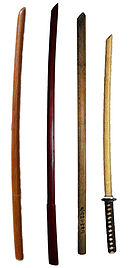Tu carrito está vacío


The bokken is a traditional Japanese practice sword that's used for martial arts training. It's commonly used by practitioners of aikido, kendo, iadio, kenjutsu and jodo. To learn more about the Japanese bokken, keep reading.
Bamboo Practice Sword vs Bokken: What's the Difference?
Some people assume that "bokken" is just another name for a bamboo practice sword, but this isn't necessarily true. Bamboo practice swords are called "shinai." While both the bokken and shinai are used in Japanese martial arts training, the former is made of wood and the latter is made of bamboo.
The wooden materials used in the bokken's construction make give it a superior level of strength when compared to the shinai. With that said, however, the shinai is somewhat more flexible, allowing it to bend and flex without breaking.
Origins of the Bokken
Like other traditional Japanese swords, the bokken has origins dating back to feudal Japan, during which it was used by samurai warriors when training. Samurai warriors preferred practicing with the bokken as opposed to a metal-bladed sword for several reasons. First, it significantly lowered the risk of injury. Secondly, they didn't have to jeopardize the integrity of their real swords when using the bokken to train.
As explained in the book "Secrets of the Samurai: A Survey of the Martial Arts of Feudal Japan," however, the bokken soon became a lethal weapon when wielded by trained samurai warriors. Even without an actual metal blade, samurai warriors could still use the bokken to perform potentially lethal blows.
Construction
There are several different construction styles of the Japanese bokken, though most mimic the size and shape of the katana. It's a medium-length practice sword with a slight curvature and handle. Other bokkens, however, are designed to mimic the appearance of the wakizashi and tanto.
The Bokken Today
The bokken is still used by Japanese martial arts practitioners to this day. In 2003, for instance, the All Japan Kendo Federation (AJKF) launched a set of exercises involving the bokken. This practice is designed for kendo practitioners with the Nidan or higher ranking.
The AJKF has further specified dimensions for the bokken. The tachi-style bokken, according to the AJKF, should feature a total length of 102 cm with a handle of 24 cm. The kodachi-style bokken, on the other hand, should feature a total length of 55 cm with a handle of 14 cm. These are the standard sizes for bokkens used in official kendo competitions.